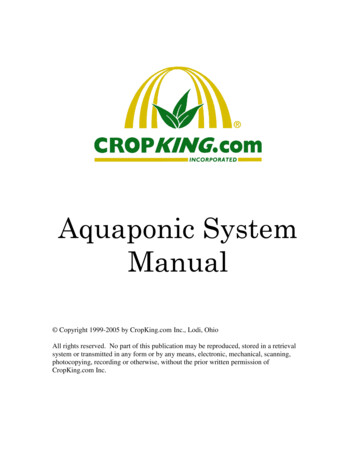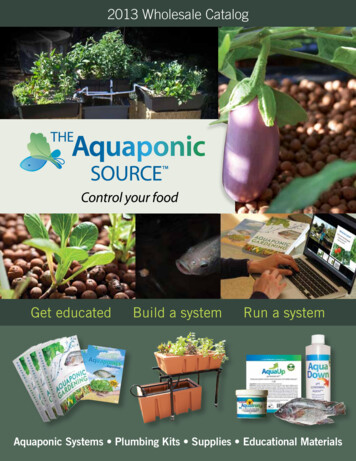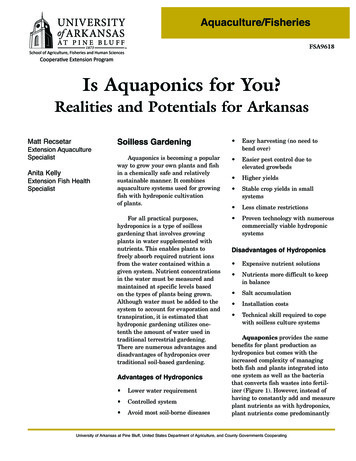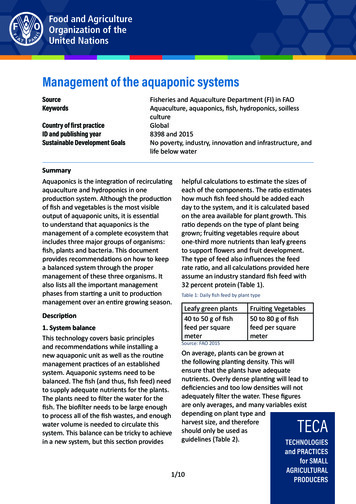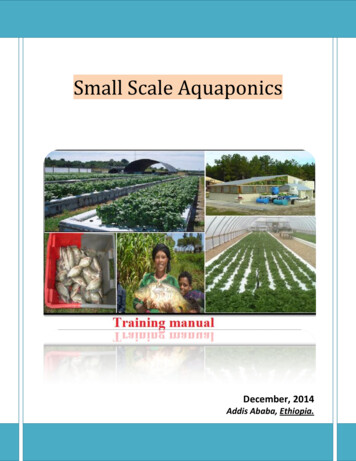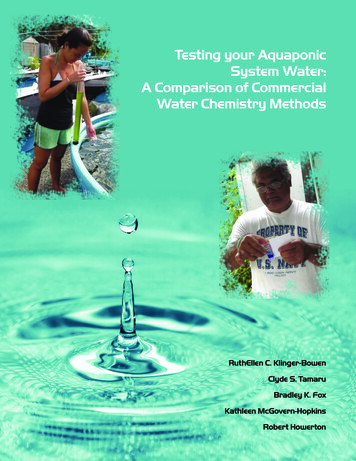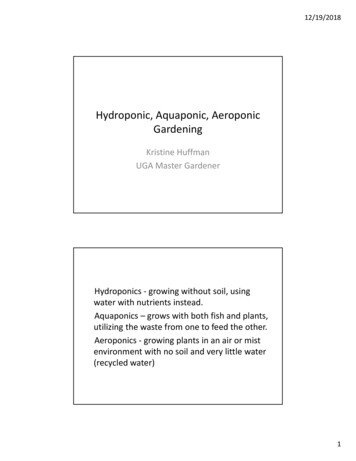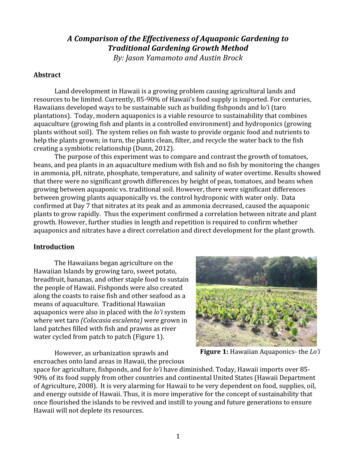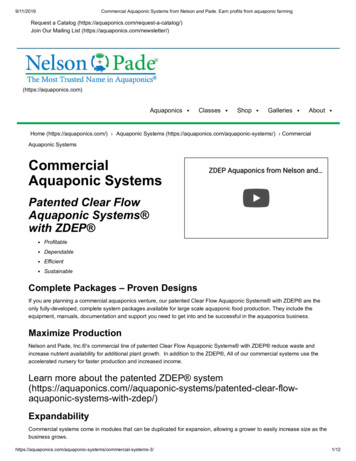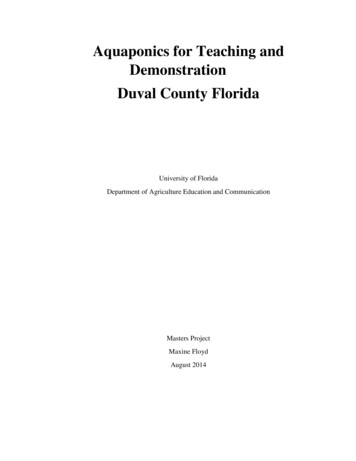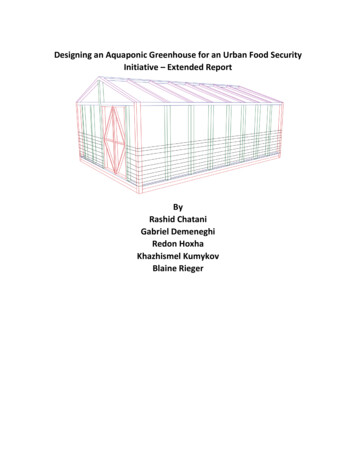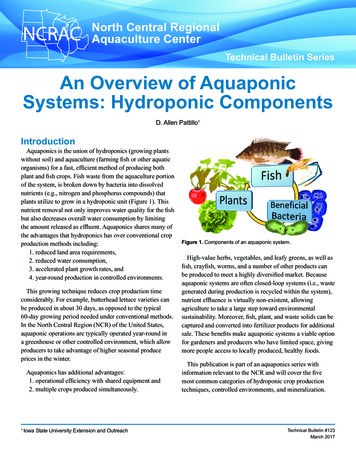
Transcription
Aquaponic systemsPotentials on a northern latitudeDavid CarlssonSpring, 2013
MID SWEDEN UNIVERSITYDepartment of Ecotechnology and Sustainable Building EngineeringAuthor: David Carlsson.Email: david.carlsson@gmail.comSpring semester, 2013.
AbstractAquaponics is a food production method that combines hydroponic and aquaculture to form a systemthat, through symbiosis, re-circulates all the water and nutrients – and thereby negates any dischargeof eutrophied or contaminated residuals – in order to grow terrestrial plants and aquatic life. To studythe possibilities of aquaponics at northern latitude, a small scale aquaponic system was constructed inJämtland, a county in the Mid Sweden region (latitude 63 ) and studied while running over a ninemonth period, August 2012 to April 2013.The fish species grown in the fish tank was a species of trout prominent in local lake and stream fauna.The plants in the growbed were a mixture of different flora with herbs as a dominating part. Waterfrom a local groundwater well was used. At start, appropriate nitrogen level in the system wasachieved by adding ammonia. The values of nitrate, nitrite, pH, carbonate and total hardness wereanalyzed in repeatedly measured samples. The values stabilized quickly and stayed stable over theduration of the experiment. Heavy metals were analyzed at one point in time and showed no levelscausing reason for alarm. Electric energy use for pumps and lighting was measured to reach close to40 kWh per month.The trout growth was monitored and found to be comparable with (equal or slightly higher than in) theconventional aquaculture where the fish were originally obtained, when comparing with the samespecies and same brood. Among flora three herbs were the species thriving best, Oregano, Rosemaryand Thyme. They kept growing throughout the winter with Oregano never ceasing to bloom. The totalmass of produced vegetables and herbs were fairly low, since the herbs grew best. Results indicate thatpresent aquaculture systems (fish only) could potentially be converted or adjusted into aquaponicsystems (recirculating and purifying the water through a growbed) and thereby decrease potential risksof fresh water pollution from fish farming, especially regarding excessive nutrients.From the results in this study it seems aquaponic systems on northern latitudes are more favorable iffocusing on fish growth, with herbs or vegetables as added benefit, and not focusing on maximizingvegetable growth. Continued studies would do well to investigate optimization parameters through, forinstance, mass balance calculations and to identify optimal mixtures of plants over the year.Keywords: Aquaponic, Aquaculture, Growbed, Biodiversity, Trout growth, Fish tank, Systemanalysis, Closed loop
Table of contents123Introduction . 11.1Purpose & Goal . 11.2Method . 1Background . 22.1The aquaponic concept . 22.2Previous research . 4Practical investigation . 63.13.1.1The design . 73.1.2Lighting details . 83.1.3Pump details . 83.1.4Some considerations during building of the prototype . 93.2Running the prototype . 103.2.1Fishless cycling - Growing the bacterial cultures . 103.2.2Electrical extensions . 103.2.3Flooding . 113.2.4Adding trout to the system . 113.2.5Feeding the trout . 113.2.6The growbed: A closer look at the plants. 123.2.7The five master building-blocks for plant-growth . 123.34Building the prototype . 6Results . 133.3.1The trout growth . 133.3.2The plants growth . 143.3.3The water quality . 163.3.4Electrical energy . 19Discussion . 204.1My prototype . 204.1.1The fish tank . 204.1.2The Growbed . 214.2Financial considerations . 214.3Potential for aquaponics on northern latitudes . 224.4Flamboyant ideas . 234.5Concluding discussion . 255Conclusion . 266References . 277Appendix . 29
1 IntroductionAquaponics is a food production method that combines the, now, traditional hydroponic andaquaculture to form a closed-loop system that, through symbiosis, re-circulates all the water andnutrients in order to grow terrestrial plants and aquatic life. To study the possibilities of aquaponics atnorthern latitude, a small scale aquaponic system was constructed in Jämtland, a county in the MidSweden region (latitude 63 ) and studied while running over a nine month period, August 2012 toApril 2013.The underlying cause for this experiment adheres to the clear and present fact how humans, on aglobal scale, are in a constant need of growing crops and feeding our families. Regarding how theways to do so is constantly being commercialized and streamlined from the traders’ point of view tothe consumers. Commercial trading in the grand scope, as it is today, is not on a sustainable path. It issooner on a trail to which there is no gain without a continuous diminishing of natural resources andno way of closing the circle. While the ideas concerning ecological farming, locally produced crops,and so on, are on a slight rise, these ideas are not without problems of their own. As such; opinionsfrom those who look to secure their own cash-flow, flowing through conventional ways of procuringfood, act as spanners in the works for any new, improved or else changed approach. As with almostevery other tiding of innovative conduct they start off climbing a wall of antagonistic opinions,purposive or not. Nevertheless; through this report I intended to convey an idea concerning anunconventional way of producing food in a small scale and to compare results to the related, currentlyconventional, way. For this a small scale aquaponic system was constructed.1.1 Purpose & GoalAs purpose and targeted goal for this thesis laid the research regarding and surrounding the feasibilityof whether or not a small-scale homebuilt aquaponic would work on northern latitude.The target goal will be to ascertain the possibility to, in an energy-effective and cost-effective way,produce vegetables and fish in such volume that it’d be feasible for a family, for a larger complex orfor an even larger area, such as a city-wide system, to employ this method. The progressive headwayof this study will be aligned in order to show how well the trout grows in the built aquaponic systemcompared to a conventional aquaculture with the same trout species of the same brood as well asfinding out what plants grows best, out of a gathered selection, in this system to supplement the troutgrowth by purifying the water.1.2 MethodOverall and in brief; this investigation, this case-study, is based on an experiment on a constructedaquaponic-system and its performance. The experiment is detailed in the report as to allow for furtherinvestigation in the same area to either further my results or attempt contradicting them.The method regards, as the goal states, the challenge to in tandem; construct, measure, examine,recount and lastly propose possible potentials of a year-round food production at home. To compareand assess results with those gathered from studying other systems and theories. And finally combinethese studies to contrasts and derive conclusions in order to find the weak points and the strengths forthis study at local level with entrained global inspiration.Thus; this report is based on literature studies regarding aquaponic systems, research and experiments.Results derived from underlying research and the construction of a prototype as well as from runningand managing said prototype to carry out tests over a winter season. The coming chapters will moveon to describe, in further detail, to how certain parts was constructed, what method of construction was1
chosen, how some preparations came about and what issues and problems was encountered. Thechemical balance will also be looked into and examined. The log kept for the entirety of the projecttime and all measurements of and results from chemical and physiological analysis, weighting, andinformation about seeds and plants used which are all available locally. The trout were weighed byresetting a scale when a bucket of water was placed on it. In order to be able to double check thefigures the filled bucket was also weighed and the numbers saved for “double counting” the averageweight. Once the bucket was in place the trouts were netted and put into the bucket. Once gathered thebucket was weighed and an average weight per trout could be calculated. The parameters measured ofthe water contain the chemical analysis of the water to see, over time; pH, carbon and total hardness,content of nitrite and nitrate. An inductively coupled plasma mass spectrometer (ICP-MS) was used tomeasure concentrations of twelve metals. ICP-MS is a variant of mass spectrometry that is able todetect metals and non-metals at very low quantities. The results regarding plants and their growth arebased on trials and ocular observations. The results regarding fish growth are based on weighting on ascale. Comparisons were made to fish growth in a conventional aquaculture growing trout, based onthe same batch from which specimens for the aquaponic were gathered.2 Background2.1 The aquaponic conceptBefore going into the details of this work I will begin with explaining what is meant by an Aquaponicso that there will be no misconceptions about this further on as much of this work is based on just that.Aquaponics is a food production method that combines the, now, traditional hydroponic withaquaculture in a symbiotic relationship that facilitates a sustainable system with little input necessaryas all the water and nutrients within are re-circulated in order to grow terrestrial plants and aquatic life.Aquaponics is, in a 2009 article in "World Aquaculture", defined as "The integration of two separate,established farming technologies - recirculating fish farming and hydroponic plant farming." (WilsonLennard, 2009). Similarly, the Oxford English Dictionary defines Aquaponics as "a system ofaquaculture in which the waste produced by farmed fish or other aquatic creatures supplies thenutrients for plants grown hydroponically, which in turn purify the water" (Oxford Dictionaries, 2013).As these preceding definitions shows, the word "Aquaponic" rather clearly denotes a combination ofthe words "aquaculture" and "hydroponic". The term "Aquaponic" is still a bit prospective and hasonly just recently, as of September 2012, been brought into the Oxford English Dictionary (OxfordDictionaries, 2013). Even though it states how the word originated from the 1930's a few years ago itwas not searchable here.The word "Aquaponics" does also appear as an entry on Wikipedia, and did so much earlier than thedictionaries, demonstrating that this concept has moved into the public domain and suggests howinterest surrounding it is on a rise. As of March 25, 2013, this open source repository of knowledgeonline encyclopedia, whose knowledge evolve with time as information is updated by its users,defined Aquaponics as:"[Aquaponics] is a sustainable food production system that combines a traditional aquaculture(raising aquatic animals such as snails, fish, crayfish or prawns in tanks) with hydroponics(cultivating plants in water) in a symbiotic environment. In aquaculture, effluents accumulate in thewater, increasing toxicity for the fish. This water is led to a hydroponic system where the by-productsfrom the aquaculture are broken down by nitrogen fixing bacteria, then filtered out by the plants asvital nutrients, after which the cleansed water is recirculated back to the animals. As existing2
hydroponic and aquaculture farmingtechniques form the basis for allaquaponicssystems,thesize,complexity, and types of foods grownin an aquaponics system can vary asmuch as any system found in eitherdistinctfarmingdiscipline"(Wikipedia, 2013)The traditional reference compendiumsprovide further understanding aboutwhat the definitions hydroponics andaquaculture can encapsulate if they'recombined. The Oxford Dictionarydefined aquaculture as "the rearing ofaquatic animals or the cultivation ofaquatic plants for food." (OxfordDictionaries, 2013) and the MerriamWebster Dictionary's definition reads"the cultivation of aquatic organisms(as fish or shellfish) especially forFigure 1 - The Nitrogen Cycle, in an aquaponic. Chart by author.food" (Merriam-Webster Dictionary,2013). About hydroponic the Oxford Dictionary says "the process of growing plants in sand, gravel, orliquid, with added nutrients but without soil." (Oxford Dictionaries, 2013) where as the MerriamWebster Dictionary defines it as "the growing of plants in nutrient solutions with or without an inertmedium (as soil) to provide mechanical support" (Merriam-Webster Dictionary, 2013) signaling thecardinal difference between it and conventional farming.Even though plant growth in an aquaponic is visually and systematically vastly different from aconventional growth, in farms and the likes, the same natural requirements is in place. And althoughthe actual science of Aquaponics is still in the early stages of its development, the biochemical cyclewithin it, cycling within the system, is quite well understood. The most important is the nitrogen cycle(figure 1), which in an aquaponic is the key element cycle as it symbiotically provides fertility toplants as well as cleans the water for the fish, removing the toxicity they'd be subject to otherwise. Thenitrogen cycle here occurs as the water flow through from fish tanks to biological filters containingbacteria situated on surface areas, to plants or a growbed and back again.The major input into this nitrogen cycle – except for electricity which here is required for the pump tocirculate the water – is fish food which is either in the shape of commercial fish feed or aquatic plants,depending on the type of fish and plants in a given situation. After the fish eats the food they producewaste. This fish waste, as well as any uneaten fish food, starts to break down and, from this, themajority of the nitrogen content form ammonia (NH3). This ammonia is then, thereafter as it flowsthrough the biological filter where Nitrosomonas bacteria is situated, converted to nitrite (NO2) afterwhich a second type of bacteria, Nitrobactor, converts nitrite into nitrate (NO3) (Manahan, 2010). It isthis nitrate that then, as it flows through the growbed, serves as a fertilizer for the plants therein. Assuch the plants, in this hydroponic component of the system, take up the nitrate - that helps them grow- by removing it from the water and as such purifies it as it circulates back to the fish tank returningclean, fresh water for the fish to thrive in.3
An aquaponic system can work with several types of aquatic animals being grown. In my scenario theanimal in question is a local family of brown trout (Salmo trutta morpha lacustris). The trout is a rathertolerant species with an inherent resilience allowing it to survive a certain shift in pH range and itthrives in temperatures between 4 and 20 degrees centigrade, peaking at 10-15. It is, however,susceptible to harm should the water become too warm, effectively making trout a less viable optionfor warmer latitudes. It also requires a high level of water oxygen content, so an aquaponic systemmust be constructed taking this issue into consideration (see 3.1.3). In general almost any freshwaterfish and shellfish can be cultivated using aquaponics. Similarly, a wide range of plants can be grownin this kind of system. It is, however, easier to grow plants that do not have large roots that mightcause them to rot, depending on what system-flow you utilize. More information about varieties of thiswill follow in section 3.1.4. Plants within a low to medium nutrient requirement tend to do best. We'lllater go through how a variety of herbs seemed to grow best in my example where I tested a variety ofdifferent plants, and not just vegetables for food production, simply to observe potential differences ingrowth affinity and adaptation.Today we can read and hear about an increase in the popularity of these systems (Rakocy, 2010). Moreand more organizations are considering a potential use of aquaponics in terms of its vast array ofbenefits including a reduction of aquacultural runoff, reduction of the need for irrigation in cropgrowth, a non ocean-depleting source of fish-stock, the potential to grow food on areas of poor soilquality as well as on polluted land. There's also an interest growing from the educational sector asaquaponics displays a variety of teachings in "ecological literacy" within an easily graspable, viewableand functional system. There are also ideas how aquaponics can operate as a certain community-hub,creating activity, training and job-opportunities. However, despite all these benefits there was no realdocumentation or conclusion found regarding whether or not aquaponics is a profitable venture in thisregion (Mid Sweden region, Jämtland County, latitude 63 ). Therefore this turned an interesting topicto research.2.2 Previous researchResearch in terms of aquaponic systems from this latitude is sparse. A deviation to such a statement isshown in an example of how some studies regarding aquaponics have taken place on this latitudeprior. But instead of focusing on a systematic improvement these have focused on education. Oneexample is the European collaborative project "Play with water" which Mid Sweden University tookpart in for their teacher education (Play with Water, 2007). The objective of that project was todescribe the systems and how the work with them had proceeded, to evaluate possibilities to use thesystem in education and then to evaluate the general pupil understanding of it. While I'm sure this wasa good project it didn't really fall in line with my aim.Another example is "Kattastrands kretsloppsodling" in Härnösand, Sweden. They've been buildingand attempting aquaculture and aquaponic ideas, in rather small scale although larger than myexample, for the last 15 years. This is a European Union-project with a goal to develop anddemonstrate the possibility to use aquaculture together with plants in places where there is a lack ofwater and not aimed at optimizing growth in the system (Kattastrands kretsloppsodling, 2012). Theirsystem, at times, operated in higher temperatures than mine did and they did not cultivate the samespecies of local fish but rather koi or goldfish. In total their amount of produced vegetable reportedlyweighs 10 to 20 times their amount of produced fish. There was, however, hard to draw conclusions interms of economic growth and systematic improvements from this project.This brings me to draw inspiration from research in other areas. From 2004 we can find a quitenotable, and descriptive, publication by Dr. Rakocy about the financial angles of aquaponics (Rakocy,4
2004). In this study he compares the levels of productivity and gross income of basil and okra firstgrown in conventional fields versus those grown in an aquaponic-system. Rakocy’s study shows asturdy 18 (basil) and 3 (okra) times higher productivity respectively, in an aquaponic compared to theregular field. The study took place in the Virgin Islands where the gross income levels from basil andokra, based on the current market prices there, came in at a projected 515 worth of vegetable grownper cubic meter, per year, in the aquaponic-system versus a 172 worth of vegetable grown per cubicmeter, per year, for the conventional system. To highlight; a cubic meter of a growing-area within anaquaponic-system yielded more vegetables, more harvest, and therefore reached a higher figure. Then,when adding in fish sales, in their case consisting of tilapia, the system had a projected gross 132,245versus 36,808 per year on the same growing area. That is; the same size area of growth wascompared with one being a regular area of cultivation and the other being an aquaponic growbed, thelatter being able to add the fishes tied to the system, present in a nearby fish tank, into the calculation.This might give aquaponic production an initial appearance as the economically superior choicebetween it and conventional field productions, but as has often been the case for discussions and whatseem to be an oft reoccurring issue is that this study does not, like several others, take into accountcosts of production. Neither does it conduct a cash flow analysis in order to determine any estimatednet income, which would be a crucial calculation to any investor, farmer, complex or business ownerwho might consider an aquaponic installation. This, as with most of Rakocy's research, based onnumbers from an outdoor tropical growing system No outdoor field or aquaponic system would workall year round in Mid Sweden’s cold climate. Thus, the results from Rakocy's work are not directlyapplicable to aquaponic systems in where this experiment took place.To make a greater effort into seeing how financial aspects could tie into the ideas of aquaponics wealso have to look further into the fact that an aquaponic can be constructed in a multitude of ways andvolumes. Given that fact one can easily realize that a potential financial outcome would differdepending on the form and variant of an aquaponic at a given location. So, to clarify how theimportance of such differences can become something of a sudden paramount we look at some oldfindings showing how it, already at a construction level, becomes important to align an aquaponicdepending on the wished outcome. The component ratio, the ratio of solid media for growing to water,can be altered to align and optimize for fish production or plant production depending on aconstituents wish and plan (McMurty et al. 1988 and McMurty et al. 1990). As such there can be amaximization reached, in terms of profitability, here as well as in a maximization of productionthrough the component ratio. This alone does not guarantee an economic offshoot, it is simplyprovided to show how there is in a venture such as this, just like any other, a plurality of differentdivisions to take into account. However, it stands to show that by employing an aquaponic systemthinking there opens up new areas and thus new potentials for combined and increased cash flow.5
3 Practical investigationTo find out whether a small scale aquaponic, on a northern Scandinavian latitude would functionaccording to theories and perhaps more importantly would work and give a positive result at anorthern latitude where I live I could have read to days’ end. Instead I decided that I would design andconstruct my own aquaponic. There I would be able to, from first hand, measure and observe itsprogress and functions. During the summer of 2012 I commenced and subsequently finished itsconstruction, after which the system was running from late summer 2012 and throughout the writingof this report in spring 2013. More details about this construction will be covered in the next chapters.The construction was based to operate on spare heat. Evidently it was not built outside as temperatureshere in northern Scandinavia drop beneath freezing for a good portion of the year. The aquaponic wasconstructed in a workshop area, free from chemical and combustion exhaust, which kept between 9-16degrees centigrade during winter. As such, not a completely stable temperature, with eight degreesvariation, but this was an intended design to test the system with an estimated median for a mimickednatural variation in summer temperature.3.1 Building the prototypeThe aquaponic building materials was mainly consisting of reused equipment, the largest of which wasthe two International Bulk Containers (IBC’s). They had previously been used by a printing office andhad contained some kind of ink additive. This was many years ago. I judged that they could be cleanedout enough to support life. After physically cleaning the IBC’s out I filled them up with water, leavethe lids off, and leave the tanks in the sun. This was simply to discover if any algae-growth could takeplace inside the tanks, and so ensure their capability to support life. After only a few days, algaegrowth was detected. Before the construction I had researched different ways of construction andfound (Rakocy et al. 2006) out that a “flood & drain”, also called an “ebb & flow”, system would bemy system of choice, as opposed to a “continuous flow” (see further section 3.1.4). I was, however,not sure this was the best way of going about, so I ensured my system could, with small adjustments,be arranged to work as a “continuous flow” system as well. “Flood & drain” seem to be the mostwidely used method of delivering water and nutrients to plants and so to filter the water upon its returnto the fish tank. There is a vast multitude of ways one could construct a “flood & drain” system. Themain construction was finished after six days, upon which the system was started and its circulationensured to function as intended. The system was formed to include the following: A fish tank with room for 500 liters of water. Constructed from an IBC.A grow bed situated above the fish tank, to enable water to flow back without the use of asecond pump and to keep the levels of light in the fish tank down. Constructed from an IBC.The light metal cage of the IBC’s cut and constructed to act as a frame for both the fish tankand the growbed, so that the weight of the water would not bend plastic or put unnecessarystrain on its, now, cut edges.A water pump, situated 10 cm above the bottom in the fish tank. With a built in float switch.A Growspot, a LED light for plants (see 3.1.2), and a timer to regulate it.Hosing and cordage to and from the pump and cordage to
Aquaponics is a food production method that combines the, now, traditional hydroponic and aquaculture to form a closed-loop system that, through symbiosis, re-circulates all the water and nu
